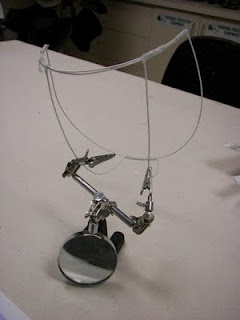Before we get to Rachel Pollock’s newest post – I need to make a correction to a previous post. Randy Handley’s notes (as mentioned in the last photo of this post) are actually kept using the award-winning system he designed, CAPS (Computer Aided Paperwork System). Co Star is the system that catalogues the PlayMakers/DDA vintage costume collection. Sorry Randy!
And now on to Rachel…
Remember Miss LaCreevy’s scalloped hat from back in September? If not, you can read the first part of the production process in this prior post.
When last we left off, we saw how the hat developed from designer Jan Chambers’ costume rendering of the character of Miss LaCreevey, through research images and millinery magazine articles to a first mockup, made from cheap wire and craft lace. Essentially, the hat had left the page, but wasn’t nearly ready for the stage yet!
We fit the mockup on the performer who will play Miss LaCreevey, DeDe Corvinus. We looked at the hat with the costume and talked about visual issues like the scale of the brim compared to the scale of the dress and how it looked on Ms Corvinus–adjustments were made in the shape of the cap and the height of the scalloped brim, so that the hat would be more in-tune with the aesthetic intent of Jan’s design concept for the character. We also discussed fit and stability–was the crown too large or too small for Ms. Corvinus’ head, and what would help stabilize it for the show? Once i had all these answers and adjustments to make, it was time to do the “real thing”!
The entire hat is built on a wire foundation, from a special kind of wire called millinery wire–18 gauge steel wrapped in cotton or rayon fiber. The joins are secured with a cotton-covered tie wire (florists use this too) and then cemented over with Super Glue for maximum stability.
Here’s the base foundation clamped in a jeweler’s support while the adhesive on the wire wrappings dries. While waiting, i also shaped the scalloped brim support in the same wire.
The finished base with the edges bound in silk bias, which will make a nicer finish for securing the fabric elements of the hat to the foundation.
Next, i attached the lace to the scalloped wire foundation, added some pleated ribbon edging, and whipped the whole brim onto the front of the base foundation.
This picture shows a second cap-shape mockup from muslin.
Jan wanted to change the shape of the crown after the first fitting, and i wanted us to look at it in inexpensive muslin to make certain it was correct before cutting into the silk taffeta of the final fabric. This shape was enthusiastically approved, so i forged ahead!
Here’s a back view of the hat before the silk cap is installed. You can see the tulle ruffles attached to the frame to give the cap loft (or in layman’s terms, “poofiness”).
Then, i had only to attach the silk cap, put in a mesh support for pinning it to Ms. Corvinus’ hair, line it, and voila! Thus a hat comes into being!
Just for fun, let’s compare, page to stage…
Here’s a closeup of Jan’s design, showing Miss LaCreevey’s sweet scalloped hat:
…and here’s the finished product, ready for opening night:
Hope you have enjoyed reading about the production process of one of our many, many hats for this show, as much as i have enjoyed making it!
–Rachel Pollock, Costume Crafts Artisan






